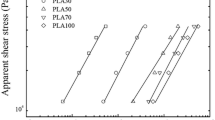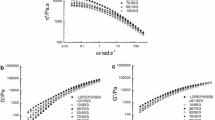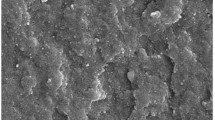Abstract
It was found that incorporation of a third component — LDPE — in the starting two-component blend is an effective method of regulating the spinnability of melts of dispersions and decreasing the effect of superadditive jet spread. The decrease in the degree of jet spread with an increase in the concentration of LDPE is due to accumulation of undeformed particles of disperse phase, formed as a result of destruction of maximally deformed particles of LDPE in the inlet zone and capillary of the spinneret, in the dispersion coming out of the spinneret hole.
Similar content being viewed by others
References
K. Dietrich and H. Versaumer, Faserf. Testilt.,26, No. 7, 347–352 (1975).
A. P. Nikolaeva, S. E. Zabello, et al., Khim. Volokna, No. 6, 23–26 (1978).
O. V. Romankevich, K. V. Yakovlev, et al., Khim. Volokna, No. 1, 21–22 (1984).
A. A. Gerasimchuk, Development of Technology for Composite Fibres with a “Matrix-Fibril” Structure Containing Polyethylene Terephthalate as the Disperse Phase, Candidate Dissertation, Moscow (1987).
Yu. A. Budash and O. V. Romankevich, Izv. Vyssh. Uchebn. Zaved., Tekhnol. Leg. Prom., No. 1, 46–48 (1989).
O. V. Romankevich, K. A. Zubovich, and Yu. A. Budash, in: Proceedings of the 2nd All-Union Scientific-Technical Conference on Rheology and Optimization of Processing of Polymers [in Russian], Izhevsk (1989), p. 113.
Yu. A. Budash, Development of Technology for Film Fibres from Melts of Polymer Blends Based on Polypropylene, Candidate Dissertation, Kiev (1994).
C. D. Han, Rheology in Polymer Processing, Academic Press, New York (1976).
O. V. Romankevich, T. I. Zhila, et al., Vysokomolek. Soedin.,A24, No. 11, 2282–2290 (1982).
A. S. Chegol' and N. M. Kvash (eds.), Analytical Control of Production of Synthetic Fibres [in Russian], Khimiya, Moscow (1982).
A. Ziabicki, Fundamentals of Fibre Formation: The Science of Fibre Spinning and Drawing, John Wiley, New York (1976).
R. E. Eckert, J. Appl. Polym. Sci.,7, No. 5, 1715–1729 (1963).
O. V. Romankevich and S. Ya. Frenkel', Kompoz. Polim. Mater., No. 14, 6–12 (1982).
K. Dietrich and R. W. Heldt, Faserf. Textilt.,26, No. 8, 404 (1975).
K. Dietrich, Lenzing. Ber., No. 42, 136–142 (1977).
F. N. Cogswell, Appl. Polym. Symp., No. 27, 1–18 (1975).
Ukraine Patent No. 371; Russian Patent. No. 1714000.
Additional information
State Academy of Light Industry of Ukraine, Kiev. Translated from Khimicheskie Volokna, No. 6, pp. 25–28, November–December, 1995.
Rights and permissions
About this article
Cite this article
Romankevich, O.V., Budash, Y.A. & Stepura, O.A. Spinnability of melts of three-component polymer blends. Fibre Chem 27, 401–405 (1996). https://doi.org/10.1007/BF00556170
Issue Date:
DOI: https://doi.org/10.1007/BF00556170




